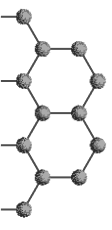ABSTRACT
Zirconium alloys are widely used by the nuclear industry as fuel cladding materials. However, within the extreme environment of fast neutron irradiation, high temperature and corrosive cooling media zirconium claddings exhibit dimensional instabilities as a result of irradiation induced growth, irradiation enhanced creep, and hydrogen pick up [1-3]. These instabilities can significantly limit the lifetime of fuel assemblies, impacting on power plant efficiency as well as waste production by requiring more frequent shutdowns and fuel removal. Many studies have been carried out to investigate the origin of this dimensional instability, and a correlation has been observed with the formation of various dislocation structures. However, a mechanistic understanding is still elusive. Recent X-ray diffraction based substructure characterization either by synchrotron or laboratory experiments can supplement transmission electron microscopy investigations. Recent results on dislocation loop formation by both neutron and proton irradiated Zr alloys will be presented and discussed to reveal the present understanding of irradiation damage in Zr alloys used in the nuclear industry.
- Griffiths, M., 2008. Microstructure evolution in Zr alloys during irradiation: dose, dose rate, and impurity dependence. Journal of ASTM International, 5(1), pp.19–26.
- McGrath, M.A. & Yagnik, S., 2011. Experimental Investigation of Irradiation Creep and Growth of Recrystallized Zircaloy-4 Guide Tubes Pre-Irradiated in PWR. In Journal of ASTM International. pp. 875–898.
- T. Seymour, P. Franke, L. Balogh, T. Ungár, S.P. Thompson, D. Jädernäs, J. Romero, L. Hallstadius, M.R. Daymond, G. Ribarik, M. Preuss, Evolution of dislocation structure in neutron irradiated Zircaloy-2 studied by synchrotron x-ray peak profile analysis, submitted to Acta Materialia.
BIOGRAPHY
Prof. Tamás Ungár obtained his Ph.D. degree from Hungarian Academy of Sciences in 1988. He is currently a Professor Emeritus at the Materials Physics Department, Eötvös University Budapest, Hungary. His research interests include X-Ray small angle scattering on Al-base alloys, High resolution X-ray and neutron diffraction for the characterization of substructures in crystalline materials, dislocation structures, Burgers vector analysis, grains size and size-distribution, planar defects, twining and stacking faults, and different types of internal stresses. He received the Hanawalt award issued by the International Centre for Diffraction Data (ICDD) in 2007 and the Alexander von Humboldt Research Prize during 2008/2009. Prof. Tamás Ungár has delivered more than 100 invited lectures at different international conferences and symposia. He published over 220 journal papers and 3 book chapters with more than 8000 citations and an H index of 46 (Source: Web of Science).
Date & Time
Venue
Chair

